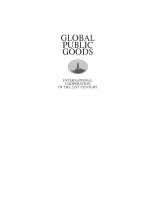Psychology applied to modern life adjustment in the 21st century, 11e chapter 1
Bạn đang xem bản rút gọn của tài liệu. Xem và tải ngay bản đầy đủ của tài liệu tại đây (362 KB, 30 trang )
Chapter 1
Adjusting to Modern Life
The Paradox of Progress
•
What Is the “Paradox of Progress”?
– Today, we enjoy more technological
advances, more leisure time and choices
than ever before.
– However, we are not happier. In fact, our
perceived quality of life seems to be
worse.
•
Why is this so?
The Paradox of Progress, continued
•
Possible explanations:
– Traditional sources of emotional security,
such as family, community, and religion,
have been lost.
– We are overwhelmed by rapid cultural
change.
– Mental demands of modern life have
become too complex.
– Excessive materialism has weakened social
ties, makes us insecure and undermines our
sense of well-being.
The Search for Direction,
• The greatest challenge of modern life may be
our search for meaning in life or a sense of
direction.
•
In desperation, people turn to many ineffective
and/or self-destructive sources for
enlightenment (e.g., radio personalities, cults)
•
One of the most prominent sources is self-help
books.
•
But, how valuable are they?
The Search for Direction, continued
•
The value of self-help books
– Excellent self-help books do exist. However,
many are not effective
• Their message is too vague to be useful.
• They are not based on solid, scientific
research.
• They don’t provide explicit directions for
changing behavior.
• They encourage a narcissistic (selfcentered) approach to life.
The Search for Direction, continued
• What to look for in a good self-help book:
1. Clarity in communication.
2. Books that are realistic, that don’t promise
too much change too soon.
3. Books by authors with good credentials.
4. Books with a theoretical or research basis.
5. Books that provide detailed, explicit
directions about how to alter your behavior.
6. Books that focus on a particular kind of
problem or behavior.
The Psychology of Adjustment,
• Psychology is “the science that studies
behavior and the physiological and mental
processes that underlie it, and it is the
profession that applies the accumulated
knowledge of this science to practical
problems”.
•
Adjustment is “the psychological processes
through which people manage or cope with the
demands and challenges of everyday life”.
The Scientific Approach
•
Empiricism is “the premise that knowledge
should be acquired through observation”.
•
Thus, the conclusions of scientific psychology
are based on careful, systemic observation
rather than speculation or “common sense”.
The Scientific Approach, continued
• Advantages of the scientific approach:
1. Clarity and precision – empiricism demands
that scientists state exactly what they are
referring to in their hypothesis.
2. Relative intolerance for error.
• Scientists’ ideas are subjected to
empirical tests.
• Their ideas and research are scrutinized
by other scientists.
The Scientific Approach, continued
• Experimental research: looking for causes.
–
The experiment is “a research method in
which the investigator manipulates one
(independent) variable under carefully
controlled conditions, and observes whether
any changes occur in a second (dependent)
variable as a result”.
The Scientific Approach, continued
• An independent variable – “is a condition or
event that an experimenter varies in order to
see its impact on another variable”.
–
•
The dependent variable – “is the variable that
is thought to be affected by the manipulations of
the independent variable”.
–
•
It is the variable the researcher manipulates
in the experiment.
It is usually a measurement of behavior.
See Schachter’s (1959) study in Figure 1.2.
Figure 1.2 The basic elements of an experiment. This
diagram provides an overview of the key features of the
experimental method, as illustrated by Schachter’s study of
anxiety and affiliation. The logic of the experiment rests on
treating the experimental and control groups alike except for
the manipulation of the independent variable.
The Scientific Approach, continued
• The experimental group – “consists of the
subjects who receive some special treatment in
regard to the independent variable”.
– In Schachter’s (1959) study, the
experimental group was told the shocks
would be painful.
• The control group – “consists of similar
subjects who do not receive the special
treatment given to the experimental group”.
– In Schachter’s (1959) study, the control
group was told the shocks would not be
painful.
The Scientific Approach, continued
• Determining cause and effect in experiments.
–
If the experimental and control groups are
alike in every way except for the treatment
from the independent variable (whether
shock will be painful), and
–
if a difference in the dependent variable is
found (e.g., desire to affiliate), then
–
the difference in their response must be due
to the independent variable (e.g., fear of the
painful shock).
The Scientific Approach, continued
• The advantage of using experiments is that
–
•
precise control allows cause and effect
conclusions to be drawn.
The disadvantage of using experiments is that
–
there are some variables of interest that
cannot, for ethical reasons, be manipulated
in an experiment.
The Scientific Approach, continued
• Correlational Research: Looking for Links.
– A correlation exists when two variables are
related to each other.
– A correlation coefficient is “a numerical
index of the degree of relationship that exists
between two variables”.
– It provides two pieces of information:
1. How strongly related two variables are.
2. The direction (positive or negative) of the
relationship.
The Scientific Approach, continued
• Positive Correlations – “indicate that two
variables covary in the same direction”.
–
•
High scores on variable x are related to high
scores on variable y, and low scores on
variable x are related to low scores on
variable y.
Negative Correlations – “indicate that two
variables covary in the opposite direction”.
–
High scores on variable x are related to low
scores on variable y (see Figure 1.3).
Figure 1.3 Positive and negative correlations. Variables are positively correlated if they tend to increase
and decrease together and are negatively correlated if one variable tends to increase when the other
decreases. Hence, the terms positive correlation and negative correlation refer to the direction of the
relationship between two variables.
The Scientific Approach, continued
•
•
•
•
Strength of the correlation is indicated by the
size of the correlation coefficient.
Correlation coefficients can range from 0 to
+1.00 (if positive) and from 0 to -1.00 (if
negative).
Coefficients near 0 indicate there is no
association between variables.
Coefficients near either +1.00 or -1.00,
indicate strong associations (see Figure 1.4).
Figure 1.4 Interpreting correlation coefficients. The magnitude of a correlation coefficient indicates the
strength of the relationship between two variables. The closer a correlation is to either +1.00 or -1.00, the
stronger the relationship between the variables. The square of a correlation, which is called the coefficient of
determination, is an index of the correlation’s strength and predictive power. This graph shows how the
coefficient of determination and predictive power goes up as the magnitude of a correlation increases.
The Scientific Approach, continued
• Common methods of finding correlations
between variables.
– Naturalistic observation – “careful
observation of behavior without intervening
directly with the subjects”.
– Case studies – “in-depth investigation of
an individual participant”.
– Surveys – “structured questionnaires
designed to solicit information about
specific aspects of participants’ behavior”.
The Scientific Approach, continued
• Advantages of using correlations.
–
They allow us to explore variables not
suitable for/or ethical to manipulate in
experimental research.
• (e.g., the effect of psychological trauma
on males versus females)
–
Thus, correlations allow investigation of a
broader array of psychological phenomena
than is possible in experimental research.
The Scientific Approach, continued
•
Disadvantages of using correlations.
– Correlations only tell us that two variables
are related, not how the two variables are
related.
• x could be causing changes in y,
• y could be causing changes in x, or
• z, a third variable, could be causing
changes in x and y (see Figure 1.6).
– Thus, we cannot determine cause and effect
from correlations alone.
Figure 1.6 Possible causal relations between correlated variables. When two variables are correlated,
there are several possible explanations. It could be that x causes y, that y causes x, or that a third variable,
z, causes changes in both x and y. As the correlation between relationship satisfaction and sexual
satisfaction illustrates, the correlation itself does not provide the answer. This conundrum is sometimes
referred to as the “third variable problem.”
The Roots of Happiness, continued
• What makes people happy?
•
What is not very important.
1. Money – the correlation between income
and happiness is very weak (.13) in U.S.
2. Age –accounts for less than 1% of
variation in reported happiness.
3. Gender –also accounts for less than 1%
of variation in reported happiness.









